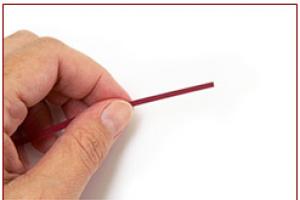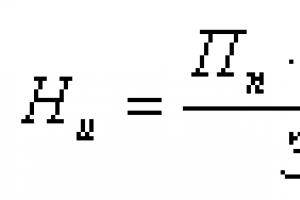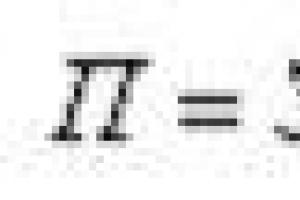The blades in a cutting tool are the basis of everything. A kitchen knife, grinder wheels, chains for a brush cutter or chainsaw with a well-sharpened blade simplify and speed up the work process.
You can sharpen a tool in a professional workshop or at home if you make a knife sharpening machine with your own hands from simple materials.
For knives used at home, you do not need a special tool for sharpening; it is enough to have a sharpener in the form of a bar on hand. But if you have a chainsaw at home, the chains of which also need regular sharpening, or an angle grinder, the disks of which constantly become dull, then it is better to make the installation yourself. The essence of the device is this: a block is attached to the desktop in two variations - with or without adjustment. For those who do not understand the essence of making a sharpener with your own hands from the text, you can watch photo or video master classes.
Device manufacturing diagram
In order for the device to turn out to be of high quality and safe, you need to calculate in advance the dimensions of the machine for sharpening knives with your own hands and select necessary materials. The first thing to do is calculate the angle between the working part of the cutting blade and the block.

Next comes the selection of base materials (support) and stone. You can make a machine from glass covered with sandpaper or stone attached to a support. The first option is less expensive, and the sandpaper can be changed at any time, but more reliable installation- made of stone.
Process nuances
In order for the machine for sharpening knives according to the drawings with your own hands to turn out perfect and last for more than one year, you need to take the advice of experts. The first thing to take into account is what type of blade will be sharpened.

After all, an individual angle is selected for each knife:
- Blades for cutting hard objects (for example, cardboard, wood, metal), chainsaws - 30-45 degrees.
- Hunting and tourist knives - at an angle of 25-30 degrees.
- Kitchen cutting tools for slicing various products need to be sharpened at 20-25 degrees.
- Simple knives for slicing bread, vegetables and fruits require 15-20 degrees of sharpening. Regular household scissors, as well as razor knives, should be sharpened at the same angle.
Necessary materials
If you need to make a sharpening machine, you will need the following materials:
- several wooden beams;
- sandpaper;
- sawing tools;
- drill with several drills.

Simple machine. Step-by-step instruction
- Step 1. Take three slats and place them so that together they form the letter H. The width of the middle rail should be equal to the width of the saw block. Repeat the procedure.
- Step 2. Place the slats perpendicular to each other, connecting their bases - the main structure for holding the saw bar is ready.
- Step 3. This is one of the most important stages! It is necessary to correctly calculate the angle of attachment of the bar relative to the slats. Calculate it using measuring tools and mark the places where the timber is attached along the vertical and horizontal slats.

If you want to universal device, then you need to make several retractable bolts at once at a distance so that you can change the slope of the beam if necessary. This can be done using simple measuring tools and drills. After this, you can cut the slats to a convenient length.

The inconvenience of such a machine is that you will have to independently control the position of the knife relative to the beam. If you don’t want to think about anything at all while sharpening knives, scissors or chains, then you should make a more complex machine.
Universal machine. Step-by-step instruction

Read each step carefully and, where possible, draw a drawing for each step indicating all dimensions - this will be an excellent help in your work:
- Cut two rectangular trapezoids from plywood, the bases of which will be equal to 60 and 170 mm, and the side will be equal to right angle– 230 mm.
- Cut a rectangular board with dimensions 230 by 150 mm.
- Fix the rectangle between the bases so that it protrudes 40 mm upward.
- Cut a block measuring 60 by 60 mm and secure it to the base of the wedge.
- Using a drill, make a vertical hole in the block at a distance of 50 mm from the center. Insert the fittings at the top and bottom of the hole, and into them - a pin of the appropriate diameter, 25 cm long.
- Process the rectangular base. At the level of the 40 mm protrusion, make a cut of approximately 2 mm so that a sheet of sandpaper can be attached to this place
- Make a fix:
- Take an L-shaped plank with dimensions of 15 by 18 cm along the long edges and an approximate width of each shelf of up to 5 cm.
- Take a rectangular plank 5 by 5 cm.
- Make a groove in the board at the level of the stud and attach the strips to it with minimal movement.
8. Make a regulator:
- Secure the stud with a nut so that it does not rotate.
- Cut a block from hard wood with dimensions of 20x40x80 mm and secure it to the stud with nuts.
- On the wide side, make a hole of 9 mm with a distance of 15 mm from the edge.
- Cut two blocks of 50x80x20 mm from hard wood and make one hole in them at a distance of 20 mm from the edge in the center.
- Take the weld of the stud and the smooth rod and fasten the blocks to it as follows: first the locking nut, then the first block. Then aluminum profile, then a second block and another retainer.
- Glue the sandpaper to the aluminum profile.

The universal sharpening tool is ready. Cut out several templates from different angles, so that you can use them as a reference when working. Remember that pre-created drawings will help you at every stage of creating a tool - do not neglect this step, otherwise it will be very difficult to avoid mistakes.
It doesn’t matter what you need to sharpen - a simple kitchen knife, garden or nail scissors, or chainsaw chains - such a tool will cope with any job if you set the angle correctly and remember to use it when the need arises.
With the help of a knife we cook food, cut food and do other housework. Therefore, it is very important that the knife blade always remains sharp. Theoretically, there is nothing difficult in sharpening knives, but in practice it turns out that not everyone can sharpen a blade well. To have an idea of what to sharpen knives with and how to do it correctly, we recommend reading our article.
Before you start sharpening a knife, you need to find out what material it is made of. There are several types of knives:
- Carbon steel knives are the most affordable, made from an alloy of iron and carbon, easy to sharpen and remain sharp for a long time. Among the disadvantages, it can be noted that the knife blade oxidizes from interaction with food or an acidic environment, due to this, rust and stains appear on the knife, and food acquires a metallic taste. Over time, after plaque forms on the blade, oxidation stops.
- Low carbon knives of stainless steel- made from an alloy of iron, chromium, carbon and in some cases nickel or molybdenum. Stainless steel knives are inferior in hardness to carbon steel, so they quickly become dull and require regular sharpening. The advantages include corrosion resistance.
- High carbon stainless steel knives – more high class knives with a high carbon content and additions of cobalt or vanadium. Due to the higher quality alloy, this type of knives does not require frequent sharpening and is not subject to corrosion.
- Damascus steel knives are mainly made as edged weapons, but there are also kitchen options. A Damascus steel knife is a multi-layer blade made from different high-quality alloys. The disadvantages include the high cost of knives.
- Ceramic knives have gained popularity due to their sharpness and ability to long time don't be dumb. But besides the advantages, Ceramic knives have a significant disadvantage, which is their fragility when dropped from a height and poor resistance to fracture.





Sharpening tools
Touchstone (sharpening stone)

Sharpening stones are available with different amounts of abrasive grains per square millimeter. Therefore, for rough sharpening and final grinding you need to use bars with a minimum and maximum abrasive content. In foreign-made whetstones, information about the number of abrasive grains is on their labeling. You have to choose domestically produced sharpening stones “by eye” or ask the seller which whetstone to use for initial sharpening and which for final sharpening.
Mechanical sharpener

Mechanical sharpeners are mainly used for sharpening kitchen knives. Although the sharpening process is quick, the quality leaves much to be desired. For this reason, for hunting and sporting knives, it is recommended to use other sharpening methods.
Electric sharpener

Modern models electric sharpeners allow you to achieve high quality sharpening due to the built-in function of automatically determining the angle of the blade. The electric sharpener is perfect for both household use and for sharpening knives in catering establishments. The lineup There is a wide range of electric sharpeners, so the price may vary, but if you want your knives to always remain sharp, then buy more “advanced” and expensive models.
Musat

Musat - designed to maintain the sharpness of the knife edge. In shape, the musat resembles a round file with a handle. Musats are included in knife sets, and many owners often confuse them with a tool for fully sharpening a blade. Please note that with the help of musat you can maintain the sharpness of a sharpened knife, but if the knife has become completely dull, you will not be able to sharpen it with musat.
Sharpener "Lansky"

This sharpener is used for sharpening small and medium-sized knives. The design of the sharpener allows you to sharpen the blade at the angle you choose. The Lansky sharpener consists of a rod with a removable touchstone and two corners connected to each other. The corners simultaneously serve as a vice for the knife and a scale for selecting the sharpening angle. The sharpener kit also includes sharpening stones of different grits with ANSI markings.
Sharpening and grinding machines

Sharpening machines are used mainly in production for high-precision sharpening of rotating shaft blades. In addition to high-precision machines, there are abrasive wheels with electric drive and rotating discs for grinding. Sharpening knives on such machines should only be done by an experienced craftsman, because due to the speed of rotation of the circle or disk and the high heating temperature, with any unsuccessful movement, the knife blade will become unusable.
Do-it-yourself blade sharpening
Sharpening a knife using a whetstone
Sharpening of a blade made with a sharpening stone is considered to be of the highest quality, of course, provided that it was carried out by experienced master. To sharpen a knife on a whetstone, do the following:

How to sharpen a knife using a sharpening stone, see also in the video:
Sharpening a hunting knife on a Lansky sharpener
Hunting knives are made of hard steel, so their initial sharpening requires sharpening stones with a low content of abrasive grains.

How to sharpen knives in a Lansky sharpener, watch the video:
Sharpening scissors
Sharpening of scissors must be done on a special sharpening machine. Sharpening blades using improvised tools ( sandpaper, edges of the glass, etc.) can temporarily improve the sharpness of the scissors, but not for long. If you do not have the opportunity to have your scissors sharpened by a professional, you can try to sharpen them yourself on an abrasive stone. When sharpening you need to follow a few simple rules:

When sharpening scissors, do not rush; patience will be your ally in this matter.
You can also watch the video on how to quickly sharpen scissors:
Sharpening plane and chisel blades
Sharpening the blade of a plane and a chisel are practically no different from each other. Therefore, the sharpening process described below applies to both tools:

Besides manual sharpening, the chisel can be sharpened on a machine with a rotating abrasive disc:

Do not forget that when sharpening products on a machine, a lot of sparks and small particles are generated that can get into your eyes, so be sure to wear safety glasses. To avoid damaging your hands on the rotating disk, wear gloves.
You can also learn how to sharpen tools from the video:
Tips for quickly sharpening a blade using improvised tools
Stone
You can quickly sharpen a knife on a hike or on a picnic using an ordinary cobblestone. Use any stone lying on the ground instead of a whetstone and run the knife blade along its surface. You won't achieve razor sharpness, but you will return the knife to working condition.
Second knife
It is quite possible to sharpen two knives at once, without sharpening stones or tools. To do this, you need to take a knife in both hands and begin to sharpen the blade of one knife on the blade of the other. After 5-10 minutes of this work, the knives will become sharper than before.
Glass objects
The knife blade can be slightly sharpened on the rough edge of glass or ceramic objects. For example, about the bottom of a glass or the edge tiles. The main thing is that the surface is rough.
Leather belt
A leather belt is more suitable for finishing and shaping a knife blade razor sharp than for rough sharpening. But if there is nothing at hand except a belt, then you can try to sharpen the knife on it. To do this, you need to give the belt a stretch and start moving the blade along it, strong pungency You may not achieve it, but you will polish the knife to a shine. 
By learning to sharpen knives and tools yourself, you will acquire a skill that will be useful to you throughout your life!
Currently, there are several types: a machine for sharpening knives, a machine for a hairdressing machine, and others. This article talks about how to make a machine for sharpening knives at home: detailed drawings with dimensions, photos and videos (2-3 videos) are presented.
Often, when sharpening knives at home, household members use abrasive whetstones. However, in order to use them in practice, you need the necessary skills and experience working with them. After all, if the knife is sharpened at the wrong angle, the blade remains dull.
Layout of the block to the blade.
Before actually manufacturing the machine, you need to listen to the advice of sharpeners.
When sharpening a knife, the master performs the following actions:
Defines the angle between the working area of the blade and the block. Moreover, for each model the angles are different;
The knife is located at an angle of 90 degrees to the direction of the block. The grooves that are formed when the razor blade of the knife rubs against the block should be at 90 degrees to the knife line. The angle in such a situation is equal to half the sharpening;
Typically the angle is 25 degrees;
The mechanic begins processing from the beginning of the foot blade;
When adjusting the sharpening angle, the master paints over part of the foot blade with any marker. As a result, the mechanic directly controls the work area.
As a rule, after sharpening the working blade has non-uniform deformations. Therefore, when processing independently, the “point of reference” should not be the sharp part of the knife.
Choosing whetstones for sharpening a knife

The main indicator of a block is its grain size.
The whetstone is the main component that makes the blade thin and sharp. As a result, before choosing a design, you need to select the necessary blocks.
When sharpening knives on their own, household members use these types of whetstones
which have a high grain size. Using such bars, the shape of the leg blade is corrected.
having medium grain size. With the help of such bars, the mechanic removes the grooves that are formed during the initial processing of the knife
whetstone, which is covered with GOM paste. In such a situation, the mechanic polishes the blade.
When processing knives for the kitchen, you can use two types - with medium and high grain. And also in this case it is necessary to use a touchstone.
Base
When making a sharpening machine at home, you can use various parts. In particular, you can use laminated box plywood 12 mm thick, which was previously used to create radio equipment housings.
When constructing a machine at home, a household member performs the following actions:
Selects a base for such an installation, which must weigh at least 5 kg. Otherwise, it will be impossible to sharpen chopping devices and tools on the machine. Therefore, in the manufacture of such equipment, the tenant uses various steel angles measuring 20x20 mm;
Next, 2 parts are cut out of plywood with a jigsaw, which have a trapezoidal shape, the base is 170 by 60 mm, and the height is 230 mm. When cutting, the mechanic makes an allowance of 0.7 mm for sharpening the ends: they end up straight and fit according to the markings;

Installs 3 parts between the inclined walls on the sides - an inclined surface made of plywood with dimensions of 230 x 150 mm.
In such a situation, the trapezoidal sides are located laterally on a rectangular surface.
The result is a base - a wedge. In such a situation, a protrusion of an inclined surface measuring 40 mm is formed in the front part;
Then, along the side wall ends, the mechanic marks 2 lines with a thicknesser. At the same time, it retreats by half the thickness of the plywood;
Drills the ends of the inclined surface and connects the base parts for a while;

From behind the structure, a mechanic connects side walls using a 60x60 mm block, which is attached to the end with two screws on both sides; - makes a 10 mm gap in the block.
In such a situation, it retreats 50 mm from the center - 25 mm from the edge. To maintain a vertical position, first drill with a thin drill from 2 edges, and then expand;

Then, at the top and bottom, two threaded fittings are screwed into the slot, and in the fittings - a 10 mm pin, the length of which is 250 mm.
If the threads do not match the studs, the lower fitting is adjusted.
Tool support device
When making a handhold device, the following steps are performed:
Removes the flat inclined part from the base, modifies it and installs a fixation device on it, as well as the clamp of the device used;
Measures 40 mm from the edge in front and, using a garden hacksaw, uses this mark to cut out a groove, the depth of which is 2 mm;
Using a shoemaker's knife, chip off the top 2 veneer layers from the end of the board. The result is a sample into which the mechanic inserts a 2 mm steel plate at the same level as the general surface;

The tool rest consists of 2 steel strips measuring 170x60 mm and 150x40 mm. The machine operator connects them along the large end, which has equal edge indentations, and makes 3 through slots of 6 mm.
Using bolts, tighten the planks along the cracks made. In such a situation, the machine operator leaves the bolt heads on the side of the large top plate;
Then he removes metal defects of the weld in the form of beads and grinds the plate to give it a smooth surface;

Applies a small striker plate to the edge recess, moves the slots with a drill and secures the support with bolts.
Fixation device

Second important detail The tool rest is considered to be a clamping bar. It can be made from 2 parts.
L-shaped plank measuring 150x180 mm, the width of the shelves is 50 mm (top);
A rectangle-shaped strike plate measuring 50x100 mm (bottom).
During production clamping bar The machine operator performs the following actions:
Sets the bottom bar to far edge top;
Makes 2 holes in the center and retreats 25 mm from the edges of the part, connects the parts through the holes with two 8 mm bolts;
Screws in 8 mm bolts on 2 sides. In such a situation, the head of the nearest bolt is located near the top bar;
Welds the bolt heads to the plates and grinds them in advance until roundness is formed;
Yes, the inclined board retreats 40 mm from the edge and draws a line with a thicknesser;
Makes one 8 mm 25 mm gap at the bottom and top edges;
Using markings, he connects the edges of the slots and uses a jigsaw to make a cut with an allowance. Use a file to expand the groove to a width of 8.5 mm;

It fastens the planks using a groove that is in the board; the top bolt is tightened with a nut and thus firmly fastens the plank.
Then tightens connection 2 with nut;
When pressing the bottom bar (in the niche of the base), screw a wing nut onto the second bolt.
Sharpening angle control
When adjusting the sharpening angle, the mechanic performs the following actions:
On the pin, which is located in the block of the machine base, throws big puck and tightens the nut.

The rod does not rotate in the foot; the block for adjusting the sharpening angle is made from a small carbolite block, the dimensions of which are 20x40x80 mm.
15 mm from the block edge, drill a 20 mm end on both sides, widen the gap to 9 mm, then make a thread inside;
He steps back 50 mm from the axis of the new slot and drills another one in the flat part of the workpiece - 90 degrees to the previous one. Such a slot has a diameter of 14 mm. In such a situation, the mechanic strongly flares the hole using a round rasp;
Screws the block onto the pin - sets the desired height of the eye without using fixing screws;
Secures the block on both sides with M10 hex nuts.
Using replaceable blocks and making a carriage
When making a sharpening carriage, the machine operator performs the following actions:
Welds 30 cm M10 threaded rods with a smooth rod whose thickness is 10 mm;
Uses 2 solid bars 50x80 mm and the thickness is 20 mm. In all blocks, in the center and on top, 20 mm is retreated from the edge, and then a gap is made 10 mm wide;
Screws a wing nut onto the rod, then a large washer and 2 bars, then a nut and washer;

Clamps rectangular sharpening stones between the stones or makes several replaceable sharpening stones.
As a timber base, the machine operator uses a rectangular tube from a profile or a piece of cornice, the width of which is 50 mm;

He sands the flat machine part and cleans it of grease, and glues strips of sandpaper with a grain size of up to 1200 grit using Super Moment glue.
The sandpaper should have a fabric base, and on 1 of the blocks you need to glue a strip of suede to apply polish to the blades.
Simple homemade machine
The most common version of the machine design is 2 pairs of wooden slats, which are fastened together with screws. The machine operator installs a block between such parts.
The main reason for the popularity of usemanual homemade machine for sharpening various knives is its stability. During operation, the machine structure does not move in any way on the workbench.

When fixing the block, the mechanic uses support strips that are located between the wooden elements.
However, such homemade machine has the following disadvantages:
The master positions the blade to the stone manually. When working for a long time, it is difficult to keep track of the sharpening angle;
When making such an installation, it is necessary to use a fixing unit. The machine structure must be stable, so it must be firmly mounted on the workbench;
During the work, the ties loosen and the location of the block changes.
Another advantage of such a scheme is ease of manufacture. This machine design is most often used when sharpening knives for jointers and for the kitchen.
Wood slats can be of different thicknesses. When making a simple sharpening machine yourself, you can use various available components.
When first studying all the nuances of manufacturing, you need to watch thematic videos that describe in detail how to make a machine at home.
Any knife, even the best one, requires careful care. If you neglect this, then over time it may stop cutting. Therefore, it is important to choose the right knife sharpening device. Currently, you can find a huge number of stones and sharpeners in stores.
Types of sharpening stones
There are mainly three types of sharpening stones:
Features of sharpening various knives
To sharpen Japanese knives yourself, you must have sufficient skills in this area. After all, Japanese steel is very fragile, so it requires special care. Manufacturers recommend sharpening such knives on Japanese water stones. It is advisable to use several stones with different degrees of grain at the same time, which will help maintain the sharpness of the knives for a long time. Of course, this process is not easy and requires patience.
But to sharpen a kitchen knife, everyone is used to using a special sharpener. With its help, you can quickly and conveniently make any knife sharp. Of course, no housewife would want to use several stones for sharpening. However, thanks to their use, the knife will cut much better.

Conditions for sharpening
Choosing and purchasing a device for sharpening knives is only half the problem. It is necessary to ensure that the knife remains sharp for several months. To do this, you should choose a favorable angle for sharpening. Some believe that the smaller the angle between the edges of the blade, the sharper the tool will be. But this is not entirely true, since such an action can lead to the fact that the knife will soon lose its cutting qualities again. That is, the sharper it is after sharpening, the faster it will become dull. In this case, a pattern can be identified: the smaller the angle at which the knife was sharpened, the less strength the cutting edge of the blade will have.

Sharpening task
The main objective of this operation is to restore the sharpness of the blade. At the same time, the correct sharpening angle must be maintained. Therefore, we can say that in its process the angle that was set earlier is restored. This angle must fully comply with all technological standards. The task is completed if the knife can be used to cut the material for which it is intended.
What problems may arise during the work process?
Of course, choosing the right angle for sharpening is difficult. Moreover, such a process is difficult if there is no special device for sharpening knives. After all, if you hold the blade with your hands, it will be very difficult to achieve a uniform sharpening with the correct angles. To resolve this issue, you can use homemade device for sharpening knives. Moreover, making it at home is not difficult. And although there are currently a huge number of different sharpening devices, their design is not particularly complex, so it will take little time to manufacture such a device.

How can you sharpen a knife at home?
One of the main tasks of every man around the house is sharpening knives. Making your own device is not only convenient, but also effective. In this case, you can independently make a device that will resemble the factory one. You can also use some available tools:
- Hacksaw.
- Wooden block.
- Chisel.
- Sandpaper.
- Plane.
- File and the like.
In some villages, it is also practiced to sharpen knives on the foundation. It is made from cement-sand mortar and has a grainy surface. Of course, this method cannot be called an example to follow. But if you urgently need to sharpen a blade, and there is no device for sharpening knives, then this is a relatively good option.

Why are drawings needed?
Knife sharpeners are inexpensive. Nevertheless, many owners want to make a device for sharpening knives with their own hands. Such a device will be of higher quality than a store-bought one, since in the process of its creation only natural materials. In order for the production of a sharpener to be completed successfully, it is necessary to carry out the process according to the proposed plan:
- Purchase or make your own drawings for clamping jaws. It is very important to draw the future design in detail. Particular attention should be paid to small details.
- Draw a drawing of the left and right stop, which is necessary in order to assembled structure didn't fall apart.
- Prepare a drawing of the guide. There are several nuances here.
Guide drawing: features
To make the guide the right size, you should:

As you know, there are two main types of knife sharpening: single-sided and double-sided. Naturally, the methods of work in one and another case differ from each other. When working with knives, the following factors should be taken into account:

Sharpening planing knives
Sharpening planer knives is a rather complex process. To complete it, you need to master some knowledge and skills. A device for sharpening planing knives is difficult to find on sale. Therefore, many improve their cutting qualities using conventional sharpeners. But for this you need to acquire a modern low-speed water-cooled sharpener. To easily sharpen planer knife, you should find a smooth and ungreasy stone used in this area. It is better to use a water stone. You can find a sharpener in car workshops, where they can sharpen any blade for an additional fee.
If you thought that self-sharpening knives existed, this is a myth invented by marketers to sell their products. Any knife will become dull sooner or later. This means you will have to look for solutions to correct this situation. Today the editors of the site will tell you what methods and tools you need to use for this and, in general, what to do when your knife becomes dull.
Read in the article:
Types of devices for sharpening knives
Since the earliest days of modern civilization, stone has existed. And almost as much metal. That is why the whetstone became one of the first devices that came to the rescue of Homo sapiens. Simple, and most importantly accessible tool successfully copes with its task for many millennia.

However, in the modern world, a whetstone can only sharpen a simple hunting knife. In other cases, the quality will leave much to be desired. In addition, only soft metals can be sharpened with a stone, and if the cutting part of the blade has a hardness above 55 HRC, then you cannot sharpen it with improvised means.
Let's consider the types of devices for sharpening knives. If we talk about what kind of abrasive material is used, then the tools can be made in the form of bars or sharpening stones. By type of drive: manual or electric. You can usually find a simple mechanical machine in home kitchens.

And it is this sharpening angle that must be maintained. However, not all household tools able to sharpen a knife correctly. And that’s why in this article the editors of the site will tell you what options you can use to sharpen a knife for specific purposes.
Important! Each type of blade has its own edge angle, and during sharpening it must be held along the entire length of the workpiece surface.
Master sharpeners even conduct special master classes on sharpening knives using natural stone. You cannot buy real natural sharpening stones in a regular store. Interestingly, before the processing process it is soaked in water, sometimes with soap solution and dried after work.
Knife sharpening stones
Knife sharpening stones are one of the most available devices for any housewife. Usually they are special rectangular bars with a special abrasive coating. Such whetstones are useful for sharpening carpentry tools in the garage, as well as household utensils.

Sharpening stones, depending on the material, can be either natural or synthetic. Their wear resistance and type of grain size depend on this. And that means the quality of sharpening. Let's consider the main types of materials that are used in the manufacture of sharpening stones:
- natural stones , such as novaculite or Japanese water stone. Working with such a tool is not very easy. They require certain skills and craftsmanship;
- diamond coated bars. Synthetic, have a high degree of wear resistance. Are different affordable price;
- ceramic. They belong to a more modern type of sharpening stones. They combine the strength of diamond coating with the hardness of natural stone;
- artificial: electrocorundum or carbide. Quickly grinding abrasive is of low quality and the same price.
On the other hand, artificial abrasives are much cheaper than their natural counterparts. They are created by mixing diamond powders of different fractions, as well as electrocorundum and carbide.
Important! Of great importance in this case is the material used to glue the rock together, as well as the percentage of all elements. The stronger and better composition(this also applies to the particles themselves), the more durable the sharpening abrasive will be.

Variations of the ligament can be soft type and hard type. In the first case, the crystals are glued strictly to the surface of their base, made of a nickel alloy. In fact, the crystals are located in a very thin layer on the bar. A soft binder is a chaotic arrangement of binding and abrasive elements. The second type is less wear-resistant.
Sharpening stones for knives
As we noted earlier, more effective means Sharpening knives are natural natural stones. Their effectiveness has been proven at all stages of sharpening. Artificial analogues, although they are durable and affordable, cannot boast of ideal sharpness. Natural sharpening stones require special care, after all most important rule masters - a perfectly smooth surface of the grindstone.

Expert opinion
Tool selection consultant at VseInstrumenty.ru LLC
Ask a specialist“To check the degree of evenness of the stone, use simple method. Wet the timber and place it on a sheet of paper on flat surface. The imprint will allow you to evaluate the level of evenness of the stone.”
Novaculites, or “Arkansas”, “Turkish”, “Belgian” stones are natural schists and chalcedony interspersed with tiny particles of garnet and quartz. Today, both natural stones and their artificial substitutes are used.
Musat for sharpening knives
Musat from the outside somewhat resembles a file. In any case, this is exactly the comparison that comes to mind at first glance. The peculiarity of this tool is that its surface is magnetized, which means that metal flour will not fall on you.

Each type of grinder is designed for sharpening a specific type of tool, and has varying degrees of versatility. For example, round musat weighs little, but oval sharpens better, since its edges provide more complete contact with the surface being processed. Tetrahedral ones are more universal; here you can better refine the required sharpening angle.
Household manual knife sharpening machines
A variety of options for sharpening knives allows you to choose the tool you need. These include the usual home mini-sharpeners, known to almost everyone, and more specific devices with a polishing wheel. Like more professional ones, household systems, knife sharpening can use a movable or stationary abrasive. The sharpening angle in this case depends on the position cutting tool. Hand tools of this type, despite their simplicity and relative cheapness, are labor-intensive to operate.
Household electric knife sharpening machines
Electric sharpeners are more convenient. Working with them saves time. Most often, such drive machines have different operating modes, which are regulated by switches.

Inside the sharpener there is a sharpening disk with an abrasive coating. When electricity is supplied, the disk begins to rotate. Grinding wheels hidden inside protective casing. Despite the presence of a disk, such machines are quite compact. And the sharpening angle is regulated by a special spring, which completely eliminates errors in sharpening.
Professional manual sharpeners for sharpening knives
Professional hand tool A bit like a carpenter's vice. The object to be sharpened, the knife itself, is clamped with special clamps.
Next, the master, through a certain movement, begins sharpening, moving along the abrasive plate Himself grinder is installed on the stop. It is very important here to properly secure the machine and avoid the device slipping during sharpening.

So tame grinding machines allow the use of different abrasives, it is possible to adjust the sharpening angle in a wide range.
Professional electric knife sharpening machines
The professional tool has a large number of attachments and replaceable discs. The electrocorundum stone and finishing leather disk rotate at a speed of 90 rpm, and the first is placed in a pan of water. The combination of low speeds and constant cooling provides high-quality processing of products already at the stage of forming the cutting edge.

Professional machines are distinguished by their versatility. Usually this is a device with a massive abrasive disk. Such tools allow you to sharpen not only knives, but also locksmith tool, for example, planes and chisels. And at the final stages of work they provide the blade with razor sharpness.
How to sharpen a knife correctly
However, before you begin the blade sharpening process, it is important to understand sharpening technology. And the basics.
Optimal sharpening angles and degree of sharpness for kitchen knives
There are dozens of types of varieties of knives for different purposes: these are kitchen knives, knives for metal work. In general, the sharpness of a blade depends on the shape of the blade. And it, in turn, must correlate with certain clear correspondences of the relationships between the blade and the blade. Let's consider correct angles sharpening various tools.
For your information! Some types of knives can be so sharp that they can cut through metal. The sharpest of them are blades with a sharpening angle of 50° - such versions with certain brand steel can cut through nails.
How to sharpen a knife at home with a whetstone
This process is simple, but quite painstaking. Without sharpening experience, trying this process is pointless. Typically, craftsmen use two sharpening stones with different abrasive densities - with a large grain and a fine one.
Advice! The knife blade must be wet. You can use special oils or sharpening lubricants.
The next step is choosing the sharpening angle. Here we focus on the table above and take the range from and to. Don’t forget, the smaller the sharpening angle, the faster knife will become dull. For a beginner, it will be difficult to maintain the same angle. In order to successfully complete this stage, it is important to hold the knife with both hands.

Carefully place the blade on the blade, lower its corner to the sharpening surface and begin working. We start working on a coarse-grained stone, and then, when the edge grinding stage begins, we continue with a fine abrasive.
How to sharpen a knife with musat at home
Sharpening takes place by weight. The blade is passed along the entire length of the instrument; usually several such “passes” are enough.
The process of sharpening with musat is quite simple. The tool is placed in one hand, the knife in the other.

How to properly sharpen a knife on an electric sharpener
The sharpening process is practically no different from sharpening manually. The only difference is that in this case it is not the blade that is wetted, but the sharpening disk itself. Most often, a special tray is used to cool the disk. And the whole process is automatic.
Typical mistakes when sharpening knives with your own hands
Everyone knows that it is better to prevent mistakes than to correct them later. That is why the editors of the site have prepared a list of the most common mistakes beginners make when sharpening knives:
- Incorrect level of sharpening angle.
- Blade sharpening. It occurs when excessive pressure is applied to the sharpener by the blade, which can cause it to become damaged or even crack.
- Sharpening an unprepared tool or a worn sharpening disc.
- Use of musat at all stages of work.
- As we remember, musat is used to polish the cutting edge. Use fine-grained abrasive.
It is important to take into account all these subtleties already at the stage of organizing work. To learn how to properly sharpen a knife with a whetstone, watch this video.
Making your own knife sharpening machine
Purchase finished machine for sharpening knives is not always necessary. For household needs, you can make it yourself. It doesn't matter if it's mechanical or electric machine you will create - focus, as mentioned earlier, on already existing schemes and drawings.

What tools are needed to make a knife with your own hands?
To make a simple machine we will need: a regular chipboard block, you can use elements of old cabinet furniture. Prepare for work: a metal rod, a small piece of sheet steel 1 mm thick, several screws for fastening the structure, any abrasive material, a jigsaw and a screwdriver.
Step-by-step instructions for making a do-it-yourself sharpening machine
Let's consider assembling a simple knife with your own hands from scrap materials.
| Illustration | Description of action |
 | As we can see, the basis here is quite simple - regular board Chipboard 65×25 mm |
 | A block for fastening the base. Don't forget to sand it. |
 | We mark the places of fastenings. |
 | We fix the bent pin at a certain angle. Guide angle from 65 to 70° |
 | We cut out a pressure plate from fiberglass. We mark the mounting locations for the countersunk bolts. |
 | We fix the plate to the base. Press with a hex wrench. |
 | From the same material we grind a plate to fix the guide. |
 | We press the structure using a regular lamb. |
 | We grind an ordinary steel rod and attach a handle from an old file to it. Length 57 cm. |
 | From a plumbing clamp we take the corner fasteners for the grindstone. We also use a clamp with a clamping screw to further secure it. |
 | Sharpening stones can be made from a regular piece of laminate. We cut it into strips 2.5 cm wide, 20 cm long. Next, glue the sandpaper onto double-sided tape and you are ready to work! |
So, our sharpening machine is ready to go. We hope that our story will be useful to you. Using them you can make simple sharpening knives.








